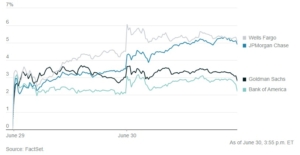Investors still view ‘bad data as good for stocks’
Investors still view ‘bad data as good for stocks’: Sevens Report Editor, Tom Essaye, Quoted in Barron’s
Nvidia Earnings Spark a Rally in Tech Stocks
“For now, investors still view ‘bad data as good for stocks’ as it makes rate cuts more likely so a small miss vs. expectations should extend the early rally,” writes Sevens Report Research’s Tom Essaye.
Also, click here to view the full Barron’s article published on May 23rd, 2024. However, to see the Sevens Report’s full comments on the current market environment sign up here.
 If you want research that comes with no long term commitment, yet provides independent, value added, plain English analysis of complex macro topics, then begin your Sevens Report subscription today by clicking here.
If you want research that comes with no long term commitment, yet provides independent, value added, plain English analysis of complex macro topics, then begin your Sevens Report subscription today by clicking here.
To strengthen your market knowledge take a free trial of The Sevens Report.
Join hundreds of advisors from huge brokerage firms like Morgan Stanley, Merrill Lynch, Wells Fargo Advisors, Raymond James, and more! To start your quarterly subscription and see how The Sevens Report can help you grow your business, click here.

